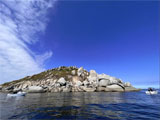Ramsbotham Rocks
![]() Wall Dive |
Wall Dive | ![]() Boat access
Boat access
![]()
![]()
![]()
Depth: 20 m (66 ft) to 30 m (98 ft)
Ramsbotham Rocks are located on the north-east tip of Great Glennie Island, which is the largest island in the Glennie Group at Wilsons Promontory, Victoria, Australia. It's a sheltered spot to dive, especially if there is a south-easterly wind blowing. The dive site features interesting rock formations and large boulders with caves and swim throughs.
The rocks slope down to a sandy bottom at around 30 metres deep.
{{wilsons-promontory-marine-reserve}}Traditional Owners — This dive site is in the traditional Country of the Boon Wurrung / Bunurong people of the Kulin Nation. This truly ancient Country includes parts of Port Phillip, from the Werribee River in the north-west, down to Wilson's Promontory in the south-east, including the Mornington Peninsula, French Island and Phillip Island, plus Western Port. We wish to acknowledge the Boon Wurrung as Traditional Owners. We pay respect to their Ancestors and their Elders, past, present and emerging. We acknowledge Bunjil the Creator Spirit of this beautiful land, who travels as an eagle, and Waarn, who protects the waterways and travels as a crow, and thank them for continuing to watch over this Country today and beyond.
Ramsbotham Rocks Location Map
Latitude: 39° 4.279′ S (39.071317° S / 39° 4′ 16.74″ S)
Longitude: 146° 13.526′ E (146.225433° E / 146° 13′ 31.56″ E)
Datum: WGS84 |
Google Map
Added: 2019-03-13 11:34:36 GMT, Last updated: 2022-04-22 03:53:43 GMT
Source: Google Earth
Nearest Neighbour: Dannevig Island North East, 3,568 m, bearing 162°, SSE
Great Glennie Island.
Wilsons Promontory Marine Reserve.
Depth: 20 to 30 m.
[ Top ]
DISCLAIMER: No claim is made by The Scuba Doctor as to the accuracy of the dive site coordinates listed here. Should anyone decide to use these GPS marks to locate and dive on a site, they do so entirely at their own risk. Always verify against other sources.
The marks come from numerous sources including commercial operators, independent dive clubs, reference works, and active divers. Some are known to be accurate, while others may not be. Some GPS marks may even have come from maps using the AGD66 datum, and thus may need be converted to the WGS84 datum. To distinguish between the possible accuracy of the dive site marks, we've tried to give each mark a source of GPS, Google Earth, or unknown.



